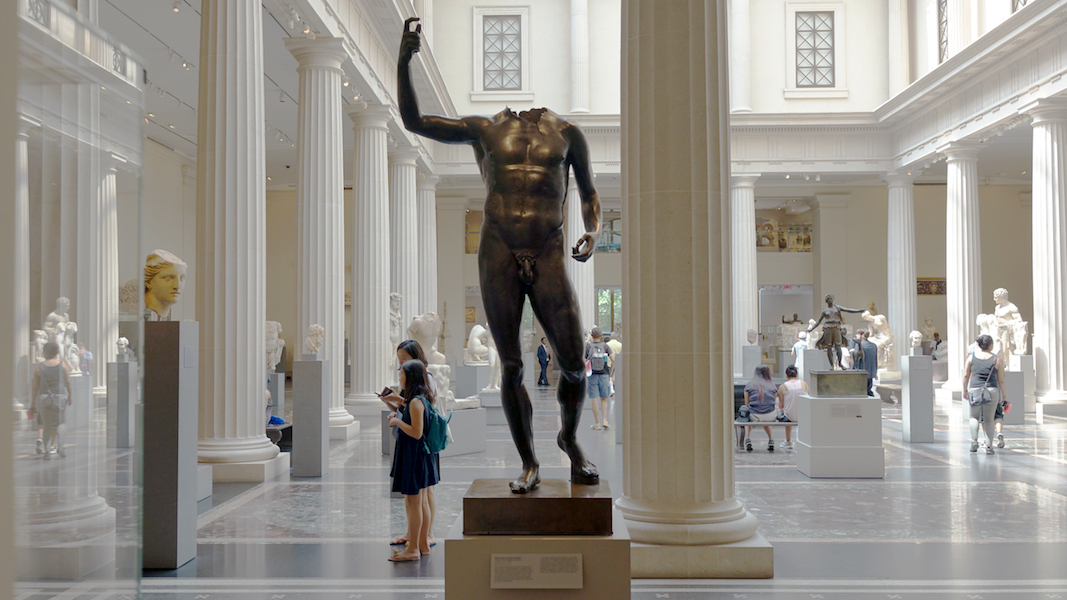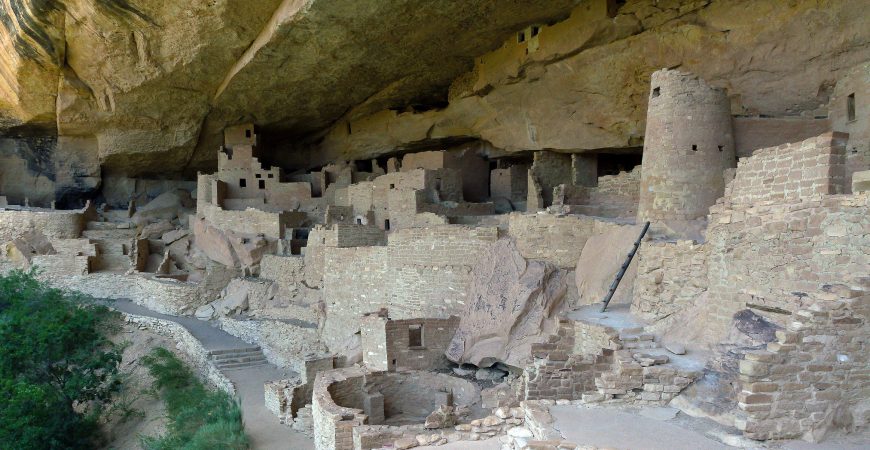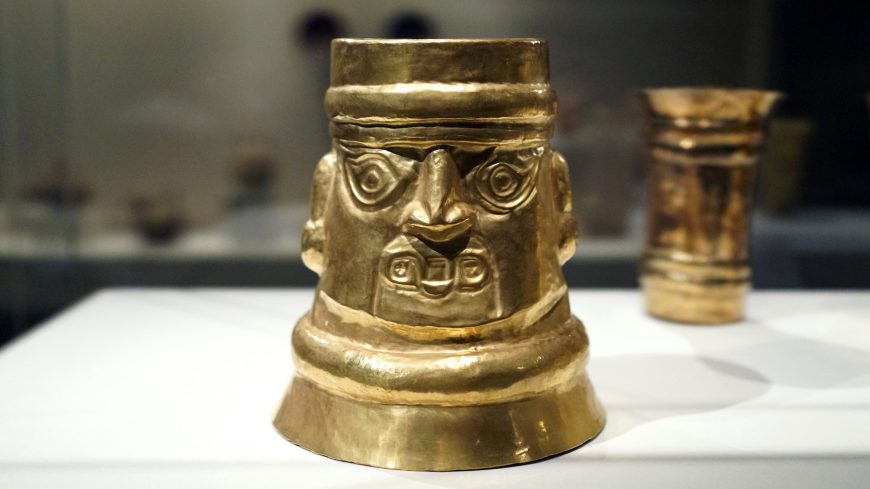14.10: What you can do now
- Page ID
- 69437
What can be done to protect cultural heritage?

The current “crisis” in cultural heritage is not a sudden development but an ongoing, complex, global problem with many causes. While it may seem simple to catch and punish perpetrators for crimes related to antiquities trafficking and destruction, in fact a lack of public understanding of the problems associated with these crimes and limited heritage-related law enforcement capacity in many countries has meant that antiquities destruction and trafficking is less likely to be prosecuted than other criminal activities (despite clear links to terrorism, international crime, money laundering, and trafficking). But there are many things that can be done on the local level to support heritage workers and caretakers and protect heritage, and there are a number of organizations that are working hard to ensure that this occurs. There are many ways that you can help.
Demand is the driver for looting and destruction
Many people are surprised to learn that legislation to protect antiquities is relatively weak or, in some cases, non-existent. Working to support and strengthen heritage protection legislation both locally and nationally, particularly when heritage is threatened by urban development or resource extraction, is one key way that ordinary citizens can contribute. There are some signs that wartime destruction is now coming under closer legal scrutiny, but most trafficked objects don’t come from wartime contexts.

One of the best ways for people to help save heritage is to remember that demand is the driver for looting and destruction. Governments can work to craft better legislation, prioritize better enforcement, greater funding, and vigorous prosecution for violators, but as long as there is a viable market for recently-looted antiquities, they will appear on the market. Unfortunately, the vast majority of objects sold online are looted or fake. It’s important to remember that smaller items like coins, pots, beads, or small statuary are often easiest to traffic and easiest to sell without a record of provenance (or origin), or with a faked record of provenance. For an object to be legally sold, it cannot have been recently looted and must have been in a private collection for a certain amount of time. You can find a helpful checklist here.
Incorporate the consequences of the global antiquities trade into curriculum
Education is another key way to fight destruction and looting. Many ordinary people are unaware of the threat to cultural heritage and thus, are not aware that there is a problem at all. One of the most important ways to address the problem of the ongoing loss of global heritage is to incorporate education about the costs and consequences of global antiquities trade into school curricula and university syllabi or through local outreach in community organizations, libraries, churches, or other public settings. At the secondary school or university level, cultural heritage awareness can be integrated into existing curricula in fields like Anthropology, Archaeology, Art History, Ethics, History, International Affairs, Law, and Political Science. Journalists also play a key role in spreading knowledge and awareness of what we all lose when heritage is destroyed or trafficked. If you are not sure where to begin, SAFE (Saving Antiquities for Everyone) has a wealth of resources available on their website to get you started.
When thinking about education, one problem is that the framing of heritage as a “global” or “universal” concern, while useful in many contexts, also has a significant drawback in that it can be invoked to insulate owners from the claims of source cultures. Nevertheless, the idea of “universal” heritage is commonly used by groups like UNESCO and others, and it has played a key role in the crafting of important international heritage protection legislation. Indeed, the creation of what we might call “heritage consciousness” in the global community is without question an important achievement.
Universal and local value
Some observers have pointed out that the heritage often designated as “universal” in the popular consciousness—and thus to receive the most attention when destroyed—tends to be the heritage of the ancient Classical Mediterranean or heritage associated with curated museum contexts. Meanwhile, other forms of heritage—for example currently inhabited sites of local significance or actively venerated religious locales—remain forgotten and unprotected.

The different responses to the destruction of the statues in the Mosul museum by ISIS or the Temple of Bel in Palmyra in 2014 and 2015, where both events gained worldwide headlines, versus the destruction of dozens of local mosques, churches, synagogues and other holy sites in Iraq and Syria, which received only minimal media coverage, brings this comparison into stark relief. Another recent example of this unequal extension of the notion of “universal” heritage is the nearly non-existent media coverage of the destruction of heritage-rich Yemen by a U.S. and British-backed Saudi campaign. Most outsiders are unaware of the war in Yemen at all, let alone its devastating consequences for antiquities.

Some observers have pointed out that ISIS specifically made the analogy between their destruction of sites of “idol worshiping” (in the form of tombs and shrines), and museums and ancient sites—which it specifically called the heritage “idols” of the West. A similar argument was made by the Taliban in 2001, when they destroyed the Bamiyan Buddhas in Afghanistan, and by Islamist rebels in Mali, who, after destroying the tombs of Islamic Sufi saints in 2012, declared “There is no world heritage, it does not exist!” Such statements show that there are real limits to the notion of universal heritage and demonstrate that the idea of “universal heritage” can itself can be turned into a weapon.
Focus on the local
Furthermore, most looting and destruction occurs outside of wartime contexts and is focused on material that often has greater local significance than “universal” significance. It’s important to recognize that if the goal of cultural heritage protection is to preserve the objects and places that give peoples’ lives meaning and which connect them to their histories and heritage, protecting sites that are meaningful for local people is as critical as protecting famous, museum-worthy ancient sites.
While we should not abandon the idea of universal heritage altogether, a deeper emphasis on ongoing looting and destruction that occurs outside of wartime contexts would be a step in the right direction (for example, during natural disasters or as a result of resource extraction, urban development, or simple poverty). An emphasis on the value of local heritage—supported and maintained by local people with international assistance—would be similarly beneficial. Fortunately there are organizations working to do just that.
There are a number of organizations that work to raise awareness and gather information to support cultural heritage protection on the local and the international level. Some, like Eamena and the ASOR Cultural Heritage Initiatives, work to track looting and gather information via satellite and other forms of reporting with an eye toward future prosecution. Others, such as Heritage for Peace, the U.S. Committee of the Blue Shield, or the World Monuments Fund, work with governments or other entities to alert them to dangers and to craft heritage protection legislation. And several organizations, including the Penn Cultural Heritage Center and the Follow the Pots Project work to support local people and educate locally and internationally to help support and preserve culture.
Additional Resources:
Neil Brodie, “It is no surprise that the looting continues,” Saving Antiquities for Everyone, August 6, 2013.
Organizations and agencies that work to protect cultural heritage

What can I do to help preserve and protect cultural heritage?
When confronted with the latest news about the destruction of cultural heritage or the latest update about a trafficking case or a questionable auction, it is easy to feel helpless and to think that the task is insurmountable if the goal is to protect and preserve cultural heritage both for the present and for posterity. Armed with information, however, each individual can become a powerful advocate in promoting a safer environment for cultural heritage and cultural property.
In addition to staying informed through study, following this curriculum, for instance, there are other paths that one can take to make a difference where cultural heritage protection is concerned. One route is to uphold best practices when visiting sites and museums, endeavoring to leave heritage sites and museums in the best condition possible for the future. This includes not removing artifacts from sites or damaging any in situ remains or museum displays.
Another route is to refuse to participate in any activities related to illicit trafficking, including online resale sites and questionable art auctions. Yet another route is to become a vocal advocate, interfacing with both governmental and non-governmental agencies that work on the behalf of culture. One can also support some of these organizations through membership and participation in outreach programs offered by some groups.
The heritage of past cultures does have a future, but it falls to each of us to make sure it is a secure future.
Organizations and agencies that work to protect cultural heritage and advocate on behalf of cultural heritage issues:
U.S. Committee of the Blue Shield
“The United States Committee of the Blue Shield was formed in 2006, in response to heritage catastrophes around the world … Blue Shield (International) and its affiliated national committees work together as the cultural equivalent of the Red Cross, providing an emergency response to cultural property at risk from armed conflict and natural disasters.”
UNESCO World Heritage Centre
“The United Nations Educational, Scientific and Cultural Organization (UNESCO) seeks to encourage the identification, protection and preservation of cultural and natural heritage around the world considered to be of outstanding value to humanity. This is embodied in an international treaty called the Convention concerning the Protection of the World Cultural and Natural Heritage, adopted by UNESCO in 1972.”
ASOR Cultural Heritage Initiatives
“The ASOR Cultural Heritage Initiatives implements cultural property protection by: Documenting damage; Promoting global awareness; Planning emergency and post-war responses.”
Archaeological Institute of America
“The AIA promotes archaeological inquiry and public understanding of the material record of the human past to foster an appreciation of diverse cultures and our shared humanity. The AIA supports archaeologists, their research and its dissemination, and the ethical practice of archaeology. The AIA educates people of all ages about the significance of archaeological discovery and advocates the preservation of the world’s archaeological heritage.”
Society for American Archaeology
“The Society for American Archaeology (SAA) is an international organization dedicated to the research, interpretation, and protection of the archaeological heritage of the Americas.“
SAFE (Saving Antiquities For Everyone)
SAFE is a volunteer group devoted to raising awareness of the world’s endangered cultural heritage.
Association for the Protection of Afghan Archaeology (APAA)
“APAA seeks to develop a broad awareness and appreciation for Afghanistan’s archaeological heritage, for the purpose of preserving cultural treasures to enhance national cultural identity as well as for the educational and financial benefit of current and future generations.”
United States Department of State, Bureau of Educational And Cultural Affairs — Cultural Heritage Center
“The ancient and historic monuments, objects, and archaeological sites of the world enrich and inform today’s societies, and help connect us to our cultural origins. The Department’s Cultural Heritage Center specializes in the protection and preservation of these irreplaceable resources, working on many fronts to safeguard the patrimony of other countries”
Foundation of the American Institute for Conservation of Historic and Artistic Works (FAIC)
“The Foundation of the American Institute for Conservation of Historic and Artistic Works (FAIC) supports conservation education, research, and outreach activities that increase understanding of our global cultural heritage.”
Art Loss Register
“The World’s Largest Database of Stolen Art”
Law Enforcement Agencies
Federal Bureau of Investigation Art Crime Team
“Art and cultural property crime—which includes theft, fraud, looting, and trafficking across state and international lines—is a looming criminal enterprise with estimated losses in the billions of dollars annually. To recover these precious pieces—and to bring these criminals to justice—the FBI has a dedicated Art Crime Team of 16 special agents, supported by DOJ trial attorneys for prosecutions. The Bureau also runs the National Stolen Art File, a computerized index of reported stolen art and cultural properties for the use of law enforcement agencies across the world.”
Carabinieri Command for the Protection of Cultural Heritage (Italy)
“The Carabinieri Headquarters for the Protection of Cultural Heritage (Comando Carabinieri Tutela Patrimonio Culturale – TPC) was instituted in 1969, one year prior to the UNESCO Paris Convention in 1970, whereby all UNESCO member States were invited to institute specific services with a view to protecting the cultural heritage of the individual nations.”
Sources for art crime, illegal antiquities trafficking, looting
ARCA – Association for Research into Crimes against Art
http://www.artcrimeresearch.org/ and http://art-crime.blogspot.com/
“The Association for Research into Crimes against Art (ARCA) is a research and outreach organization which works to promote the study and research of art crime and cultural heritage protection. The Association seeks to identify emerging and under-examined trends related to the study of art crime and to develop strategies to advocate for the responsible stewardship of our collective artistic and archaeological heritage.”
International Council of Museums (ICOM) Red List
“The Red Lists classify the endangered categories of archaeological objects or works of art in the most vulnerable areas of the world, in order to prevent them being sold or illegally exported.”
Looting Matters (David Gill)
“Discussion of the archaeological ethics surrounding the collecting of antiquities and archaeological material.”
Trafficking Culture
“Trafficking Culture is a research consortium that produces evidence-based research into the contemporary global trade in looted cultural objects.”
Curriculum materials for learning and teaching about heritage issues
Smarthistory ARCHES (at risk cultural heritage education series)
“The At Risk Cultural Heritage Education Series (ARCHES) is a new Smarthistory learning resource for the study of at-risk cultural heritage, funded by the National Endowment for the Humanities.”
Donna Yates, Antiquities Trafficking and Art Crime (University of Glasgow)


